Chapter: Electronic Devices and Circuits : Amplifiers
Advantages of Representation of Gain in Decibels
Advantages of Representation of Gain in Decibels
Logarithmic scale is preferred over linear scale to represent voltage and power gains because of the following reasons :
· In multistage amplifiers, it permits to add individual gains of the stages to calculate overall gain.
· It allows us to denote, both very small as well as very large quantities of linear, scale by considerably small figures.
For example, voltage gain of 0.0000001 can be represented as -140 dB and voltage gain of 1,00,000 can be represented as 100 dB.
· Many times output of the amplifier is fed to loudspeakers to produce sound which is received by the human ear. It is important to note that the ear responds to the sound intensities on a proportional or logarithmic scale rather than linear scale. Thus use of dB unit is more appropriate for representation of amplifier gains.
Methods of coupling Multistage Amplifiers
In multistage amplifier, the output signal of preceding stage is to be coupled to the input circuit of succeeding stage. For this interstage coupling, different types of coupling elements can be employed. These are :
1. RC coupling
2. Transformer coupling
3. Direct coupling
Ø RC coupling
Figure shows RC coupled amplifier using transistors. The output signal of first stage is coupled to the input of the next stage through coupling capacitor and resistive load at the output terminal of first stage
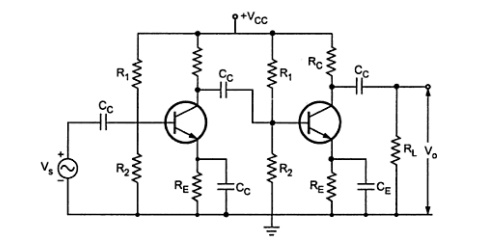
The coupling does not affect the quiescent point of the next stage since the coupling capacitor Cc blocks the d.c. voltage of the first stage from reaching the base of the second stage. The RC network is broadband in nature. Therefore, it gives a wideband frequency response without peak at any frequency and hence used to cover a complete A.F amplifier bands. However its frequency response drops off at very low frequencies due to coupling capacitors and also at high frequencies due to shunt capacitors such as stray capacitance.
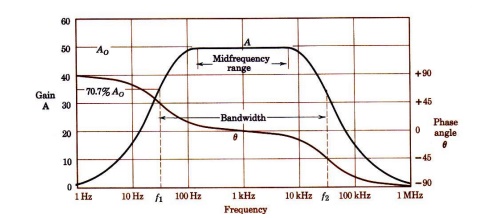
ü Transformer Coupling
Figure shows transformer coupled amplifier using transistors. The output signal of first stage is coupled to the input of the next stage through an impedance matching transformer
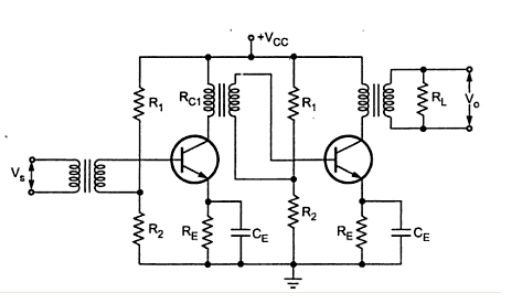
This type of coupling is used to match the impedance between output an input cascaded stage. Usually, it is used to match the larger output resistance of AF power amplifier to a low impedance load like loudspeaker. As we know, transformer blocks d.c, providing d.c. isolation between the two stages. Therefore, transformer coupling does not affect the quiescent point of the next stage.
Frequency response of transformer coupled amplifier is poor in comparison with that an RC coupled amplifier. Its leakage inductance and inter winding capacitances does not allow amplifier to amplify the signals of different frequencies equally well. Inter winding capacitance of the transformer coupled may give rise resonance at certain frequency which makes amplifier to give very high gain at that frequency. By putting shunting capacitors across each winding of the transformer, we can get resonance at any desired RF frequency. Such amplifiers are called tuned voltage amplifiers. These provide high gain at the desired of frequency, i.e. they amplify selective frequencies. For this reason, the transformer-coupled amplifiers are used in radio and TV receivers for amplifying RF signals. As d.c. resistance of the transformer winding is very low, almost all d.c. voltage applied by Vcc is available at the collector. Due to the absence of collector resistance it eliminates unnecessary power loss in the resistor.
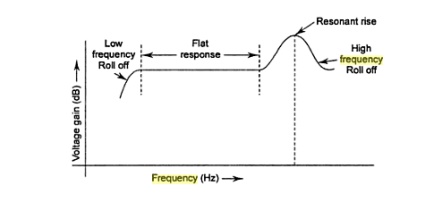
Ø Direct Coupling
Figure shows direct coupled amplifier using transistors. The output signal of first stage is directly connected to the input of the next stage. This direct coupling allows the quiescent d.c. collector current of first stage to pass through base of the next stage, affecting its biasing conditions.
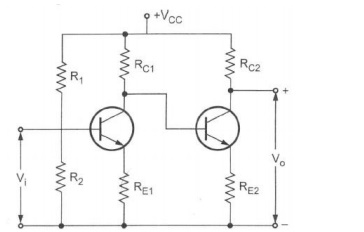
Due to absence of RC components, frequency response is good but at higher frequencies shunting capacitors such as stray capacitances reduce gain of the amplifier.
The transistor parameters such as VBE and β change with temperature causing the collector current and voltage to change. Because of direct coupling these changes appear at the base of next stage, and hence in the output. Such an unwanted change in the output is called drift and it is serious problem in the direct coupled amplifiers.

Related Topics